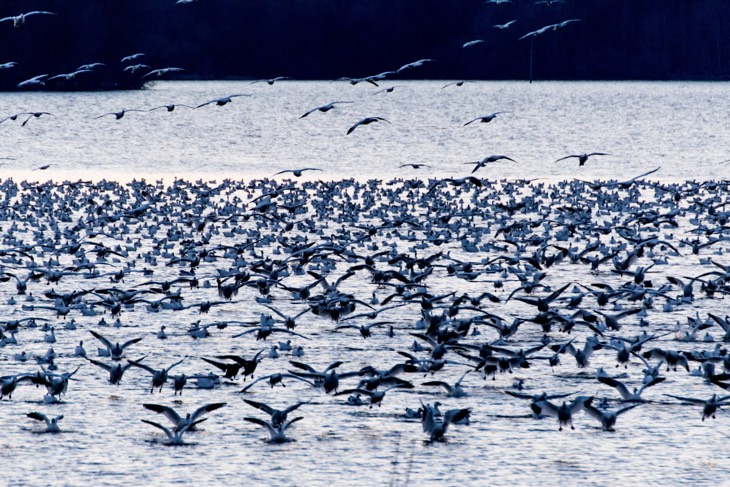From the Inuit of Alaska to the Sámi of Finland, the winter survival skills of indigenous peoples were developed over millennia of trial and error. Much of the indigenous knowledge of how to get through winter falls into the following categories:
- Shelter craft — how to build dwellings from natural, local materials that will trap heat, accommodate a fire, and provide security from storms and predators.
- Clothing — how to make layered outfits from natural materials that can insulate and stand up to abuse without getting in the way of hunting and traveling.
- Travel — how and where to migrate, so as to follow game and trading opportunities.
- Hunting and fishing — how to find and harvest game during the winter months.
Libraries have been written about all of the above topics, and given that most of this knowledge was oral and is lost to us, even those libraries come up far short of what a modern person would need to actually survive the winter without the use of present-day technologies. But there are some tips and insights that we can take from the above areas and apply to emergency preparedness.
Store and transfer heat from fires
One of the tricks Native Americans used was to store heat from a campfire or cooking pit, both by heating rocks with it and by keeping coals alive for re-use.
Sharon Day, executive director of the Indigenous Peoples Task Force, told the Star Tribune: “A pit would be built in the middle of the floor with rocks buried underneath the floor. When the rocks were heated, it would radiate the warmth.”
Indians would also wrap one of these hot rocks in a leather skin and tuck it into their bed, so the heat would keep them warm under the covers during the night. We’ve also heard of this being done with bricks that had been placed in an oven, and then wrapped in some non-synthetic cloth (synthetics melt when heated) and placed in a bed or sleeping bag.
Heat was also preserved by covering a fire pit with ash and dirt so that the coals would stay alive and be easy to use to re-light the fire the next day. Having a pre-lit coal is a huge help to getting a fire going, especially in winter weather if you’re dealing with moisture from snowfall and are having trouble finding good, dry tinder. Some of us on staff have done this on multi-day camping trips, where coals from the previous night’s cookfire are buried and then used to start the next night’s fire.
Live campfire coals were also transported to a new campsite inside a fire horn or firepot — a covered or sealed vessel filled with fine ash and moss that could keep the coal going. Sometimes the vessel was made of the cleaned-out horn of an animal, and sometimes from clay.
Make use of winter’s advantages
One of the themes that came up repeatedly in my research into this topic was the degree to which indigenous people would treat winter weather not as an obstacle but an opportunity.
First, it can be a lot easier to travel and transport heavy loads on a sled over well-packed snow than it is to do the same across rough terrain with no roads — this is true even if you have wheeled carts. You may struggle to get across uncleared brush or rocky terrain in most seasons of the year, but if all of that is pressed down and smoothed over with snow, you can easily cross it with sleds and snowshoes.
The winter’s advantages for transport really shined when it came to hunting. Indians could cover a lot of ground in the snow, and could more easily carry large volumes of meat and skins on sleds back to camp.
Frozen rivers were basically highways — totally flat, and free of obstacles like trees, deadfall, and terrain features. This made winter travel relatively easy not just for the aforementioned hunters, but also for traders.
And of course, there’s food under those frozen highways — ice fishing was a major source of wintertime calories for many tribes.
Dress in layers
All indigenous people in northern climes — from Canada’s First Nations to the Finnish Sámi to Siberians — dress in layers to keep the cold at bay. These are often layers of skins and furs, where the furs are especially critical because they impart the same protection to humans that they do to the regional animals they’re taken from.
Read more about layers and their role in surviving winter emergencies.

The Sámi wear a lot of caribou skins and furs because its fur strands make excellent insulation. Native Americans would often use bison fur, which is well-suited for the winter because it has two layers, a tough outer later that gives some abrasion resistance, and an insulating, inner down layer.
But other types of hides and skins were also popular, and work well since leather is good as an outer layer for trapping body heat.
Take an ice bath
This may seem counterintuitive, but taking a quick dip in an icy bath can help you keep your core temperature up.
The cold bath works by shocking your vascular system and constricting your blood vessels so that you have less blood flow in the limbs and retain more core body heat.
This ice bath trick is widely practiced in northern Europe, where in countries like Finland a trip to the sauna is often followed by a short dip in a pool of icy water. In addition to helping with heat retention, this practice is also thought to lower stress, improve mood, and boost the immune system.
If you don’t have a pool of water handy, another option is just rolling in the snow in the nude. This has the same effect on your system as the ice dip.
The other big advantage of deliberately exposing yourself to extremes of cold is that it builds up your tolerance for it. This increased cold tolerance will boost your ability to function outdoors, especially under stress, which is one reason why the ice bath is part of some athletes’ training regimens.
Plan ahead
A big part of indigenous winter preparations involves forecasting just how harsh the winter is likely to be. There are whole books written about different native traditions of watching certain types of animal, plant, and weather behavior as an indication that the coming winter will be more or less severe.
All of this forecasting is in the service of making plans for where to be, and on what timetable, and with what supplies. Ultimately, indigenous people didn’t just prep for “winter” generically, but for the specific winter they thought was coming based on the signals they got from their environment.
Once winter arrived, they also relied on their forecasting abilities to know when a sudden cold snap was likely to hit, or when a storm might be in-bound.
Unless you’ve lived in a region for long enough and spent enough time outdoors to soak up direct knowledge of local weather traditions, it’s very unlikely you’ll be able to benefit from this kind of forecasting. However, modern outdoor communications devices can be a great help in this regard, especially satellite communicators that will continue to work even if local infrastructure is damaged.
There’s also the old standby, the Farmer’s Almanac, but there’s plenty of debate over how reliable its seasonal forecasts are. We wouldn’t want to make too many plans based on it, but if it’s all you’ve got, it may be better than nothing.



You are reporting the comment """ by on